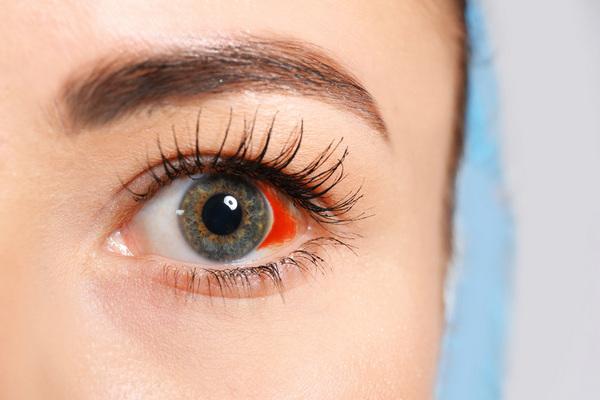Зміст
- 1 Acute conjunctivitis: Redness of the eyes
- 2 Acute conjunctivitis: Swollen, red eyelids
- 3 Acute conjunctivitis: Tingling or burning sensation in the eyes
- 4 Acute conjunctivitis: Sticky eyelids
- 5 Light sensitivity
- 6 Feeling as if “something fell in your eye.”
- 7 Conjunctivitis treatment
- 8 Relief of the symptoms of conjunctivitis
- 9 How long is conjunctivitis contagious?
- 10 Preventing the spread of infection
Conjunctivitis is redness and inflammation of the transparent film that surrounds part of the eyeball and covers the inside of the eyelid. It is caused by a viral or bacterial infection, but it can also result from allergies, contact with chemicals, or various diseases.
Viral and bacterial conjunctivitis are highly contagious. Failure to follow the rules of hygiene (not washing hands) or contact with an infected object belonging to a sick person (for example, using the same towel) is enough to contract the disease. Interestingly, conjunctivitis can also be transmitted by airborne droplets, such as sneezing or coughing. For this reason, people with viral or bacterial conjunctivitis should stay at home for several days.
Allergic conjunctivitis (caused by pollen, animal hair, cosmetics and perfumes) and conjunctivitis caused by contact with detergents are not contagious.
Below you will find information on the symptoms of acute conjunctivitis.
Acute conjunctivitis: Redness of the eyes

Redness of the eyes is a typical symptom of conjunctivitis. It can often be ignored, especially for people who do a lot of computer work. However, this redness does not go away when we rest.
Acute conjunctivitis: Swollen, red eyelids
It is a symptom that affects both infection-induced conjunctivitis and allergic conjunctivitis. Bacterial or viral conjunctivitis usually first affects one eye and then spreads to the other after a few days. Allergic conjunctivitis affects both eyes at once.
Acute conjunctivitis: Lachrymation
Viral and allergic conjunctivitis leads to high tear production. With bacterial inflammation, lacrimation is optional.
Acute conjunctivitis: Tingling or burning sensation in the eyes
This symptom cannot be ignored. The burning sensation and stinging sensation in the eyes is so intense that it interferes with your daily activities.
The type of discharge from the eye indicates what type of conjunctivitis we are dealing with. Transparent watery discharge is a symptom of viral or allergic conjunctivitis. If the discharge is purulent, green and yellow, and abundant, you are probably dealing with a bacterial infection.
Acute conjunctivitis: Sticky eyelids
If you wake up in the morning and feel like your eyes are glued together, this is a clear symptom of conjunctivitis. The discharge from the eyes builds up on the eyelids during the night and dries up, leading to problems opening the eyes upon waking.
Light sensitivity
Conjunctivitis can cause slight sensitivity to light. If you have other symptoms, such as vision problems, photophobia, or severe eye pain, the infection may have spread beyond the conjunctiva. You should see your doctor immediately.
Feeling as if “something fell in your eye.”
When you have conjunctivitis, you may feel a foreign body in your eye. This sensation is similar to the sensation of sand in the eye.
Conjunctivitis treatment
- Bacterial conjunctivitis is treated with antibiotic eye drops, ointments, or tablets.
- Viral conjunctivitis is not treatable – you just have to wait. The duration of conjunctivitis in this case is 4–7 days.
- Allergic conjunctivitis usually resolves soon after the source of the allergy is removed.
- Conjunctivitis caused by contact with detergents requires thorough rinsing of the eye with saline solution (at least 5 minutes) and immediate medical attention.
Relief of the symptoms of conjunctivitis
To relieve pain and remove mucus from viral or bacterial infections, apply a cold or warm compress to your eyes. Remember to use a different compress for each eye. This will prevent the spread of the infection. Use a clean compress every time. Clean the eye by rubbing from the center outward.
How long is conjunctivitis contagious?
For bacterial conjunctivitis, you can return to work or school within 24 hours of taking the antibiotic. Viral conjunctivitis is contagious throughout the duration of symptoms.
Preventing the spread of infection
If someone in your family (especially a child) has conjunctivitis, try not to touch their eyes and wash your hands thoroughly every time you give them the medicine. Never share towels and throw them away immediately. Change towels and sheets daily. Disinfect all surfaces that the patient touched – table, sink, doorknobs. You should also throw away any cosmetics that were used at the time of the infection.








